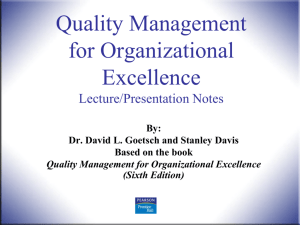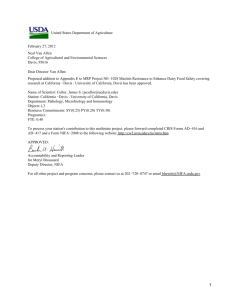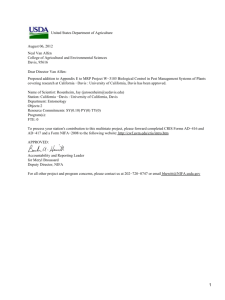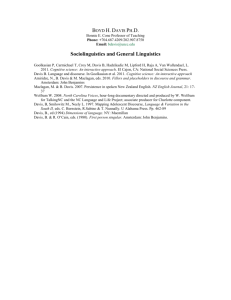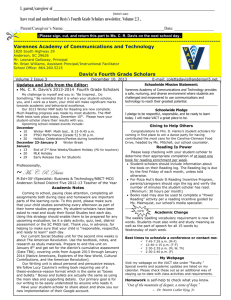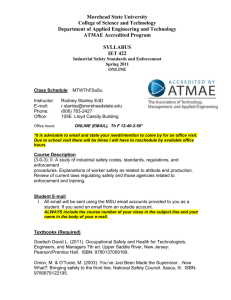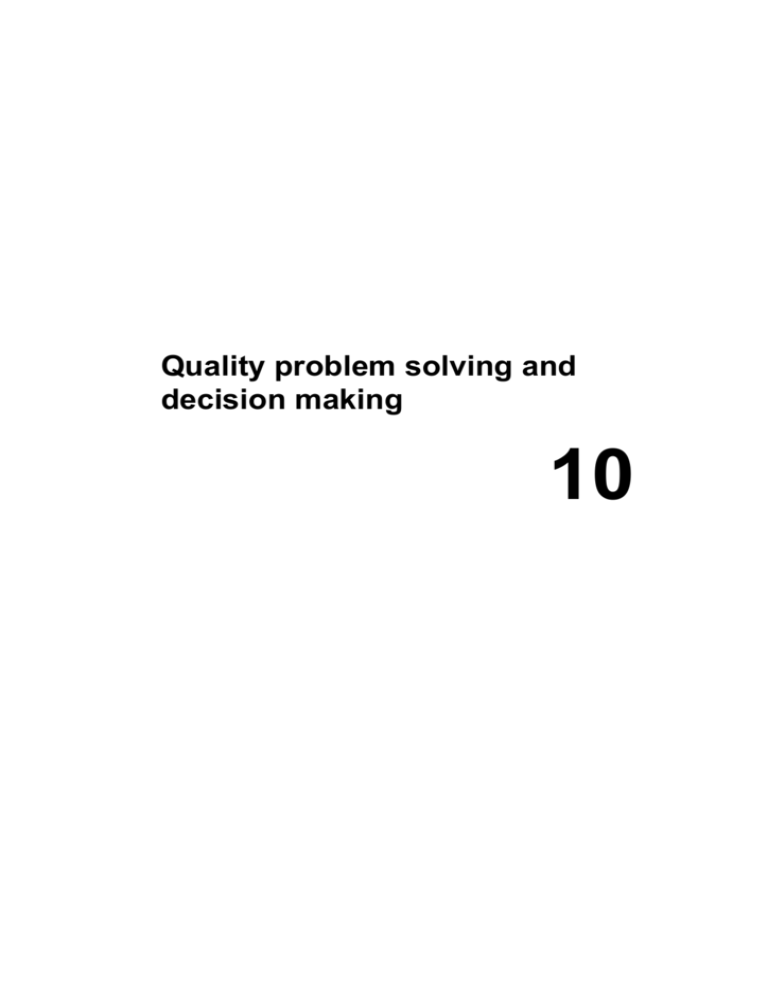
Quality problem solving and
decision making
10
Quality problem solving and decision making
Contents
Introduction ............................................................................................................. 10–3
Essential readings .................................................................................................... 10–3
Objectives ................................................................................................................ 10–3
In your experience ................................................................................................... 10–4
Recognising and solving a problem ........................................................................ 10–4
Toyota’s practical problem solving process ............................................................ 10–4
Root cause analysis ............................................................................................. 10–4
Checking the point of cause ................................................................................ 10–5
Decision making ...................................................................................................... 10–5
Scientific decision making .................................................................................. 10–6
Decision making considerations ......................................................................... 10–6
Culture, problem solving and decision making ....................................................... 10–7
Conclusion ............................................................................................................... 10–7
Further reading .................................................................................................... 10–7
References ............................................................................................................... 10–8
Review questions ..................................................................................................... 10–8
Further questions ................................................................................................. 10–8
10–2
Quality problem solving and decision making
Introduction
Problem solving and decision making are not solely quality management functions,
individuals also confront these on a daily basis. The quality management movement
has been involved in the development of a range of tools and processes which
contribute to problem solving and decision making being effective, efficient,
transparent, justifiable and ethical.
This module is about these problem solving and decision making processes, and their
importance to quality management endeavours.
Essential readings
Textbook
Goetsch & Davis 2006
Ch. 16. Problem Solving and Decision Making.
Electronic journal article
Dew, J 2003, ‘The seven deadly sins of quality management’
Quality Progress, vol. 36, iss. 9.
(Search ProQuest using the Library’s electronic resources page)
Electronic journal article
Clancy, CM & Cronin, K 2005, ‘Evidence-based decision making:
global evidence, local decisions’, Health Affairs, vol. 24, iss. 1.
(Search ProQuest using the Library’s electronic resources page)
Objectives
On completion of this module you should be able to:
1. describe what outcome must be achieved for a problem to be solved
2. explain the meaning of the terms ‘existent’ and ‘latent’ with regard to problems
3. describe the seven main steps in Toyota’s Practical Problem Solving Process
4. explain the process of root cause analysis
5. describe the six steps in the decision making process
6. describe the concepts of common-cause variation and special-cause variation
7. explain the significance of organisational culture to problem solving and decision
making.
10–3
Quality problem solving and decision making
In your experience
Consider some recent significant decisions you have made (such as, where to go on
your vacation, or what school to send your children to, or whether to join a
professional organisation, or which candidate to vote for in an election). Examining
the decision you made, as follows:
What criteria did you use to make your decision?
What research did you do to ensure the decision was ‘informed’?
Was the result effective, efficient, transparent, justifiable and ethical?
If so, describe why.
If not, describe how you could have made it more effective, efficient, transparent,
justifiable and ethical.
Recognising and solving a problem
There are many ways of describing problems and Goetsch and Davis (2006) identify
two types of problems, ‘existent’ and ‘latent’.
As described by Goetsch and Davis (2006, p. 400), in quality language, a problem is
solved ‘only when its occurrence has become impossible or significantly less
probable’.
Toyota’s practical problem solving process
Goetsch and Davis (2006, p 404) present Toyota’s practical problem solving process,
showing the seven steps as follows:
1. Perceive the initial problem.
2. Clarify the problem.
3. Determine the actual ‘point of cause’.
4. Identify the ‘root cause’.
5. Develop and implement a countermeasure.
6. Evaluate the countermeasure’s effectiveness in solving the problem.
7. Change the standard.
Root cause analysis
The concept of the ‘Five Why’s’ is not peculiar to Toyota’ process; it is common in
root cause analysis, and it is a powerful tool for ‘getting to the bottom of things’.
The electronic journal article by Dew (2003) reminds us that Deming believes the
cause of most problems in organisations is due to issues with management. Dew’s
(2003) organisation found that successive root cause analyses pointed to management
as contributing to problems and he proposes a taxonomy of management root causes
that will be recognisable to anyone who has worked in a modern organisation.
10–4
Quality problem solving and decision making
Checking the point of cause
It is important to note that Step 6 of Toyota’s practical problem solving process,
‘Evaluate the countermeasures effectiveness in solving the problem’ involves not just
checking whether the root cause has been addressed, but also checking that the point
of cause has been addressed. This seems obvious, but as we cannot be certain that the
root cause we identified at Step 4 is the only root cause, we cannot be certain that
resolving the root cause will completely solve the problem. It is also important at
Step 6 to check whether our solution has caused other problems, particularly latent
problems, as we are yet to see them.
Decision making
Problem solving and decision making are closely related. Solving problems involves
going from identifying problems to implementing solutions. At many point decision
must be made. For example, early in the process we may need to decide when to stop
doing research into the problem and to start trying out potential solutions. We need to
decide which potential solutions to try out. We need to decide and identify our final
solution as well as deciding how to sell this solution to the people who fund it and
implement it.
Goetsch and Davis (2006) describe decision making as a process rather than simply
‘deciding’, which is an event, or point at which a decision is made. Decision making
involves the steps like those shown in Figure 10–1.
Successful Decision Making
1. Define the Decision
Why make a decision?
Who to involve?
Applying what criteria?
2. Collect & Analyse Information
Continually assessing reliability, credibility & relevance.
3. Determine Options
From information, experience & invention.
4. Assess/Shortlist Options
…against criteria.
5. Make the Decision
Range of assessment methods.
6. Communicate & Implement Decision
Plan for success.
7. Review Outcomes & Process
Review for continuous improvement.
© Performance People Pty Ltd, 1999
Figure 10–1: Decision making process
(Source: Performance People Pty Ltd 1999, Successful Decision Making: Solving
Business Problems, unpublished training materials.)
10–5
Quality problem solving and decision making
The electronic journal article by Clancy and Cronin (2005) discusses evidence-based
decision making in the health care industry, and the role of information as the
evidence required for such decision making. In the absence of evidence, subjective
decision making must take place (Goetsch & Davis, 2006).
Scientific decision making
Goetsch and Davis (2006) describe Joseph M. Juran’s ‘85/15 rule’—which goes
against many assumptions made by managers. These assumptions include that people
are basically lazy and need to be motivated, and that non-performance is typically the
result of poor or lazy workers. Juran believed that 85% or more of the problems
experienced in organisations result from issues relating to processes—generally
poorly designed processes, or processes that are inadequately taught or resourced.
Deming frequently wrote about variation being the enemy of quality. Many of the
tools and techniques he championed were about reducing or eradicating variation.
Goetsch and Davis (2006, p. 413) cover the two types of variation commonly
discussed in quality literature—‘common-cause variation’ and ‘special-cause
variation’. A major challenge for anyone seeking to reduce or eradicate variation is
that of identifying special variation, while allowing an acceptable level of common
variation to occur.
In the electronic journal article by Clancy and Cronin (2005) variation is seen as a
critical aspect of health care, e.g. variation influences consumers’ perceptions of
quality of care.
Decision making considerations
Value and amount of information
The value and amount of information available and required for decision making are
critical considerations, as poor information or insufficient information provide an
element of risk. Having too much information is a problem and sometimes specialist
knowledge is needed simply to sift through available information, sorting and
discarding to produce the information needed for decision making. Other risks
include political, economic/, industrial and social views of the person sifting, sorting
and discarding information and any biases influencing this process.
Use of management information systems (MISs)
The dictum ‘garbage in, garbage out’ applies to computing systems and frequently a
significant investment in information systems does not produce a significant benefit
because the stages identified above are not implemented.
As noted by Goetsch and Davis (2006), it is also important to be aware that in
addition to computerised MIS, useful information is also available that may not be on
the system.
10–6
Quality problem solving and decision making
Creativity and decision making
Goetsch and Davis (2006) provide some good suggestions regarding creativity. A
critical aspect of creativity is the extent to which the organisational culture
encourages or stifles creativity. An understanding of this distinction can aid in
creative endeavours.
Culture, problem solving and decision making
With regard to creativity in decision making, organisational culture is critical to
successful problem solving and decision making. Organisations are much more likely
to be successful at these if they:
Value sharing of knowledge and information
Allow cross-organisational interaction
Encourage creativity
Regard failure as necessary rather than career terminating
Teach their staff how to make decisions and solve problems
Demonstrate commitment to the above at all levels of management.
Conclusion
Problem solving and decision making are critical aspects of quality management. In a
total quality environment, all parties involved in every aspect of the organisation’s
endeavours are encouraged to take part in problem solving and decision making.
Taking a structured approach, and being aware of the potential pitfalls will also assist
in making better quality decisions. The culture of the organisation will either support
participative and effective problem solving and decision making, or will prevent the
organisation from achieving its potential.
Further reading
There is an excellent report about the investigation into the fire on the Westralia
which took the lives of four sailors who were trapped in the engine room of the Royal
Australian Navy ship.
The report is from the ABC (Australian Broadcasting Commission) Radio National
program ‘Background Briefing’. It was broadcast on Sunday 9 August 1998.
The full transcript is available on the ABC Radio website at:
http://www.abc.net.au/rn/talks/bbing/stories/s11594.htm
10–7
Quality problem solving and decision making
References
Goetsch, DL & Davis, SB 2006, Quality management: introduction to total quality
management for production, processing, and services, 3rd edn, Pearson Prentice Hall,
Upper Saddle River, NJ.
Performance People Pty Ltd 1999, Successful decision making: solving business
problems, unpublished training materials.
Review questions
Review question 10–1
Draw a diagram that shows how problem solving and decision making processes are
overlapping and interrelated.
Review question 10–2
Complete ‘Discussion Assignment 16–2’ (Goetsch & Davis 2006, pp. 423-424) for
an opportunity to do a root cause analysis.
Review question 10–3
Without referring to earlier pages in this Module or the textbook, list the seven steps
in Toyota’s practical problem solving process; then list the six steps in the decision
making model.
(Refer back to pages 541 and 549 to see how well you recalled the steps.
Further questions
The Factual Review Questions and Critical Thinking Activity in your textbook are
useful for refreshing your knowledge. You may like to consider these now, or as part
of your examination preparation.
In completing the Critical Thinking Activity you are not expected to come up with a
solution, but to identify what you would look into and how.
10–8


